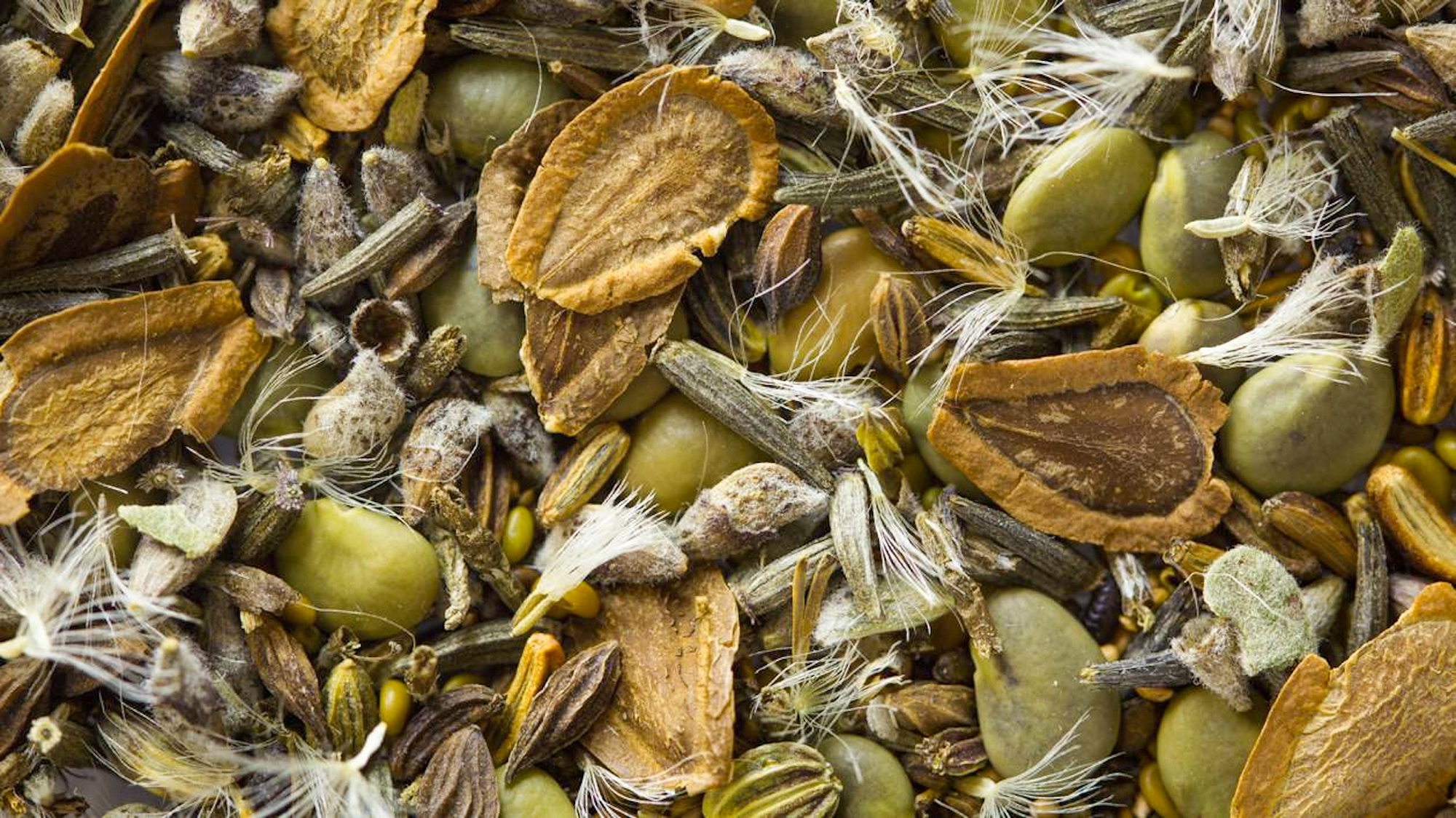Chapter 4: Native Seed
Chapter 4: Native Seed thompsbb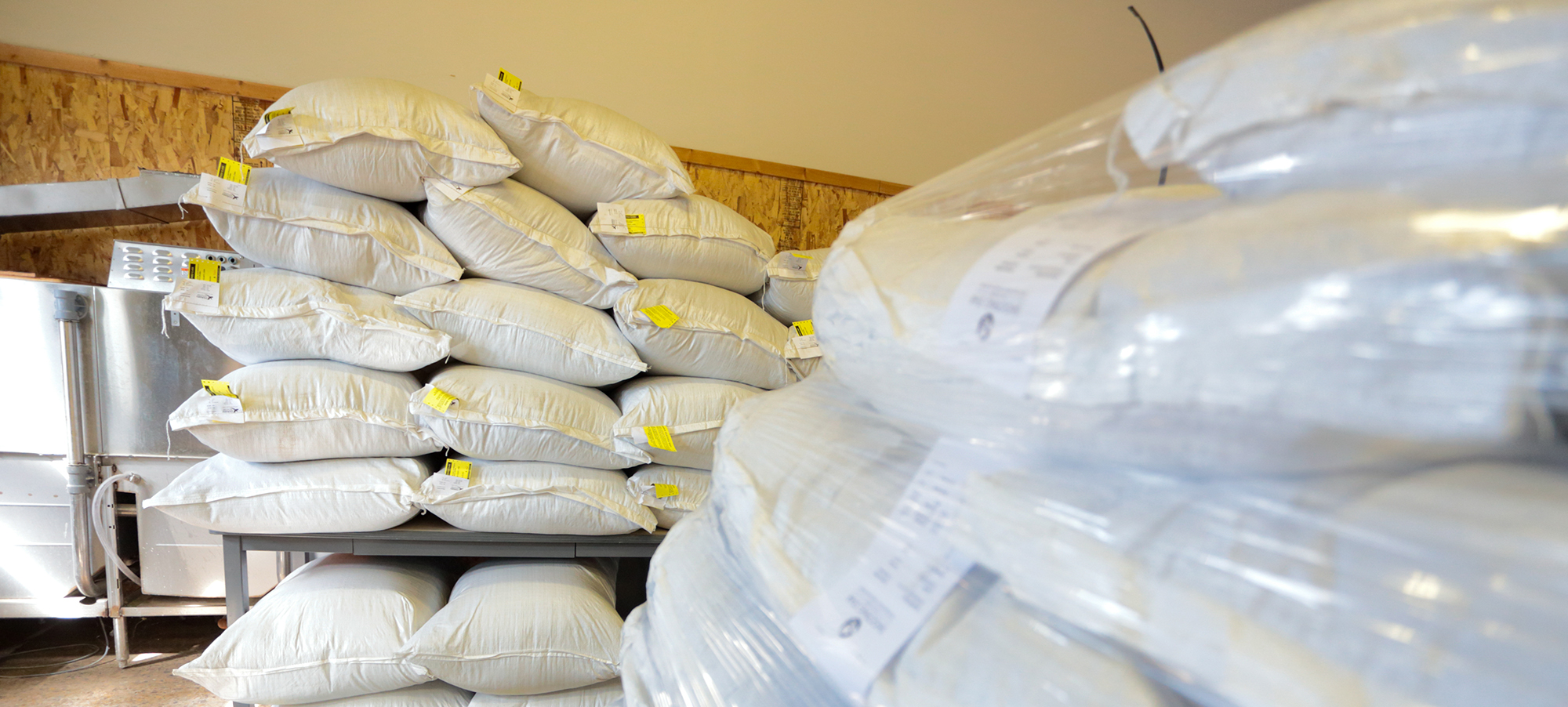
During most of the 1990s, counties and cities applied for Living Roadway Trust Fund (LRTF) grants to purchase native seed to plant in their roadsides. However, since 1998, the Tallgrass Prairie Center (TPC) roadside program manager has usually secured a grant to purchase a large quantity of seed (1,000–1,400 acres worth) to provide to counties that request it. In 2021, cities also became eligible to receive this seed. Counties and cities with an Integrated Roadside Vegetation Management (IRVM) plan on file with the LRTF that submit a request receive the seed for free and provide the labor and equipment to plant and maintain the seed.
This program serves to lower the cost of seed per acre since it is bought in bulk, freeing up more LRTF funds for other city and county requests.
Seed Request Procedure for Cities and Counties
Every fall, the TPC roadside program manager emails seed request forms to the counties and cities that have an approved IRVM plan on file, counties and cities that anticipate completing an approved IRVM plan by June 1 of the following year, and engineers and county conservation board directors in counties without a roadside vegetation program (to ensure they are aware of this benefit of having a program). Counties and cities estimate how much seed they will need the following spring when the seed pickup occurs. Once they have obtained the seed, they have until December 31 of the following year, or approximately one and a half years, to plant it. Cities and counties obtain the majority of the seed they plant through this program.
In their seed requests, counties and cities must provide location details for any planting sites involving equipment that could cause rutting greater than six inches. Some roadsides contain Indigenous burial sites and other cultural resources, and the DOT archaeologist must coordinate with Tribal nations to determine if ground-disturbing activities might disturb such sites. Planting sites using lighter equipment that does not disturb the soil do not require such review.
Counties may request a diversity mix (35–45 species) or a cleanout mix (25–30 species); both are suited to most roadside situations. The more inexpensive cleanout mixes are used more often in sites prone to silting up from adjacent farmland, which may require the county to periodically excavate the plugged-in ditch and reseed it. With the two seed mixes made available through this program, counties and cities may only need to purchase directly from commercial seed vendors when they wish to supplement these mixes with a unique mix for a special project.
For more on the request process, see Appendix 4A for a request form from a previous year.
Native Seed Categories
Native Seed Categories thompsbbUse seed adapted to local climate and growing conditions
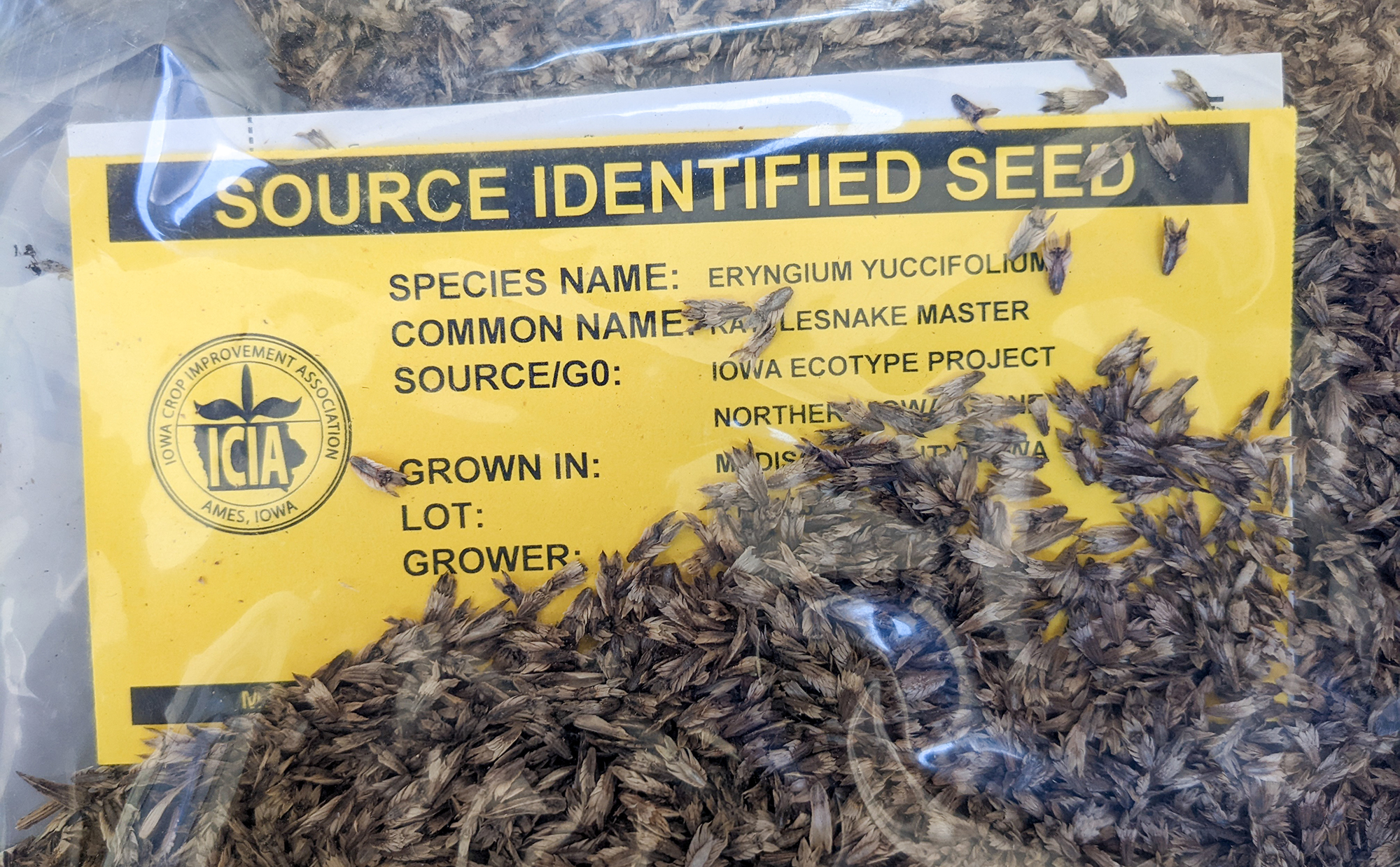
Yellow Tag Seed
Iowa source-identified seed, distinguished by the yellow tag that marks it, is highly recommended for roadside plantings. The Iowa Crop Improvement Association certifies that this seed originates from Iowa prairies, which means it is adapted to Iowa climate and soil. This seed is often collected from multiple sites within a region of the state, giving it a broad genetic base and potentially making it adapted to a wide range of growing conditions. Buying yellow tag seed also reduces the risk of accidentally introducing new weeds to Iowa. Most of the seed provided through the Tallgrass Prairie Center is yellow tag seed.
Sources of yellow tag species and related information can be found in the Iowa Crop Improvement Association’s Iowa Seed Directory. Additional native seed sources and information can be found on the Tallgrass Prairie Center’s Iowa Prairie Seed and Service Providers page.
Local Ecotype
Local ecotype seed originating from Iowa or nearby that is not yellow tag certified is also appropriate for roadside plantings. Counties or cities can obtain this seed by requesting it from vendors. Some counties establish their own local ecotype prairie grass and wildflower production plots with seed collected from prairie remnants within their county or region. Ideally, this seed will be cleaned and tested to know how much live seed (the percentage of a seed lot that is viable and able to germinate into a seedling) is actually being planted.
Cultivars
Cultivars or cultivated seed varieties are generally not recommended. Cultivars are often derived from regions too far south and west of Iowa, making them adapted to a different climate and growing season. Most are only available in a limited variety of species, are developed for forage production, and can be too aggressive in diverse plantings.
Seed Labels
Seed Labels thompsbbLearn to read them
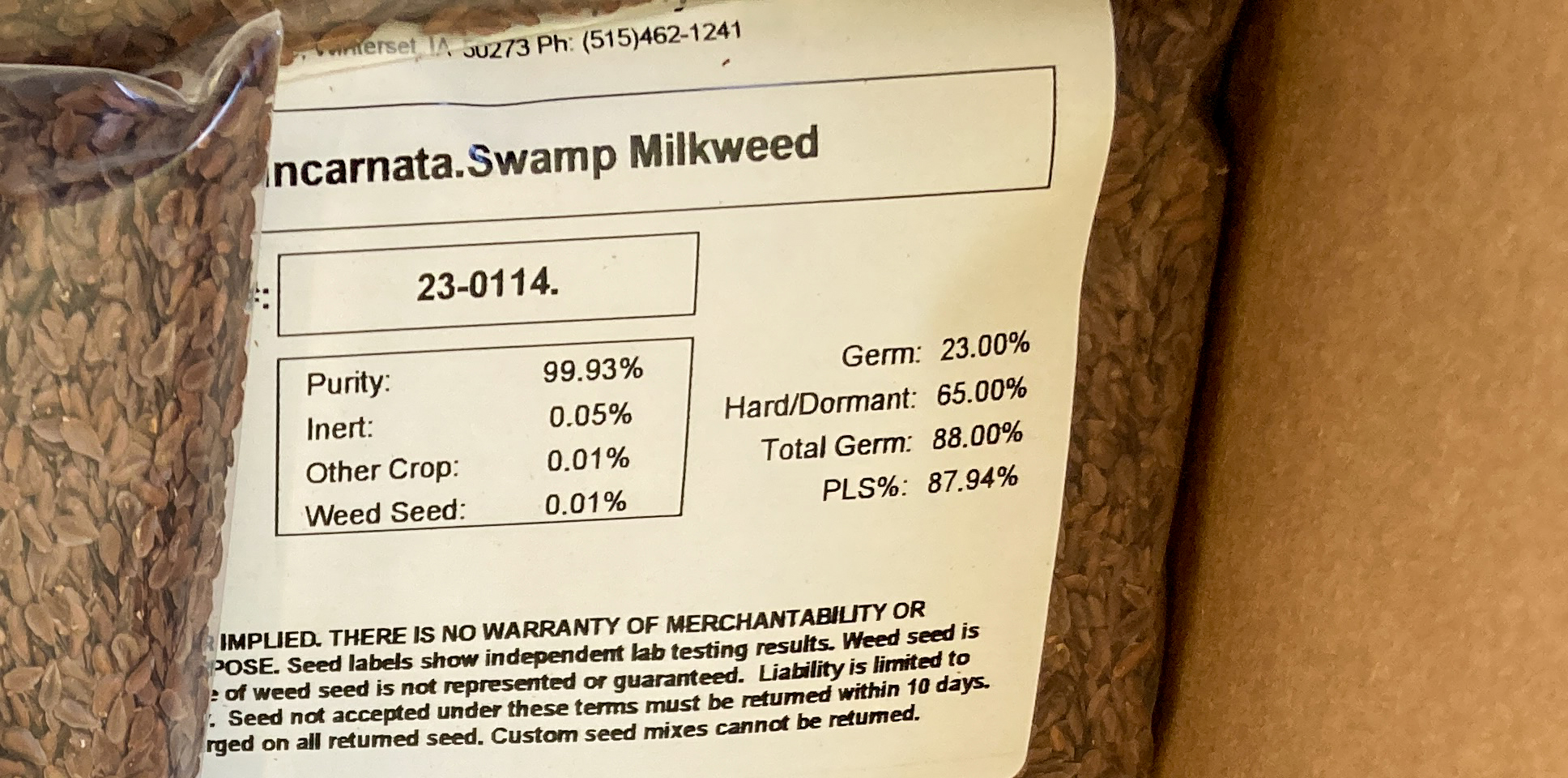
Commercial seed labels contain information related to seed quality. Labels include some or all of the following:
- Pure seed (purity): percentage of material in the bag that is actually the desired seed
- Inert matter: percentage of plant debris or other non-seed materials
- Other crop seeds: percentage of non-weed seeds
- Weed seeds: percentage of seeds considered weed species
- Noxious weed: name and amount of noxious weed seeds per pound
- Germination: percentage of seed that will germinate readily in a germination chamber
- Hard seed: percentage of seed that does not germinate readily because of a hard seed coat
- Dormant seed: percentage of seed that does not germinate readily because it requires pretreatment or weathering in the soil (some suppliers may combine hard and dormant seed on the label)
- Pounds pure live seed (PLS): determined via the calculation of (bulk seed mix lbs.) x (% purity) x (% germination + % dormant)
- Tetrazolium (TZ): percentage of seeds tested using tetrazolium chloride (for native species that will not break dormancy for germination tests, living tissue is stained red, allowing analysts to determine the viability of non-germinated seed)
The amount of weed seeds in a sample can vary widely. Some amounts may seem high but are not necessarily a cause for concern (see Roadside Real Talk on the next page for more).
Roadside Real Talk
Insights From Roadside Managers and Other Professionals
It does seem high to have, for example, 380 noxious weed seeds per pound of native seed. But I sometimes get seed lots with over 1,000 noxious weed seeds per pound. In my mind, it's negligible since the actual weed seeding rate ends up being very low, and they are not necessarily all live seeds. The noxious weeds that show up in these tests are almost invariably annual agricultural weeds, so they will probably be gone within 2–3 years. The weed seed bank (at least in post-agriculture settings) is many orders of magnitude higher than these small amounts. Weeds listed as noxious on the tag are not necessarily Iowa noxious weeds either, so depending on who you buy from, they might not even need to report it that way. In other words, you may be seeding these weeds anyway without knowing their identity (they would be listed as a whole in the weed seed percentage). For example, wild buckwheat is noxious in Minnesota but not in Iowa. It could be labeled as a weed to cover bases for interstate commerce. While I wouldn't reject a lot like this, it would be worth keeping an eye on the planting.
—Justin Meissen, Research and Restoration Program Manager, UNI Tallgrass Prairie Center, 2024
Growing and Harvesting Seed
Growing and Harvesting Seed thompsbbAs previously mentioned, some counties maintain seed production plots to supplement the seed they receive through the Transportation Alternatives Set-Aside Program or purchase separately. To learn how to establish and harvest seed production plots, refer to the Tallgrass Prairie Center’s Native Seed Production Manual. After becoming familiar with the basics of growing and harvesting seed, it can be helpful to talk with county conservation employees and roadside managers who have plots about their experiences. You can find out who currently maintains plots by emailing the roadside management Google Group email list, talking to the roadside program manager at the Iowa Roadside Management Office, or networking at the annual roadside conference or winter Association for Integrated Roadside Management (AFIRM) meeting.
Seed Storage and Viability
Seed Storage and Viability thompsbbKeep Seed Cool and Dry
The viability of native seed deteriorates rapidly at high temperatures and in high humidity.
A general rule of thumb for seed storage: temperature (Fahrenheit) plus percentage relative humidity should not exceed 100. Additional seed storage considerations include:
- Most seed will last at least a year at 50°F and 50% relative humidity.
- For each 10°F increase in temperature, seed longevity is halved.
- For each 1% increase in moisture content of the seed (not relative humidity), longevity is halved.
Example: Seed stored at 70°F and 6% moisture content has only one-quarter of the lifespan of seed stored at 50°F and 6% moisture. Likewise, seed stored at 50°F and 8% moisture content has only one-quarter of the lifespan of seed stored at 50°F and 6% moisture.
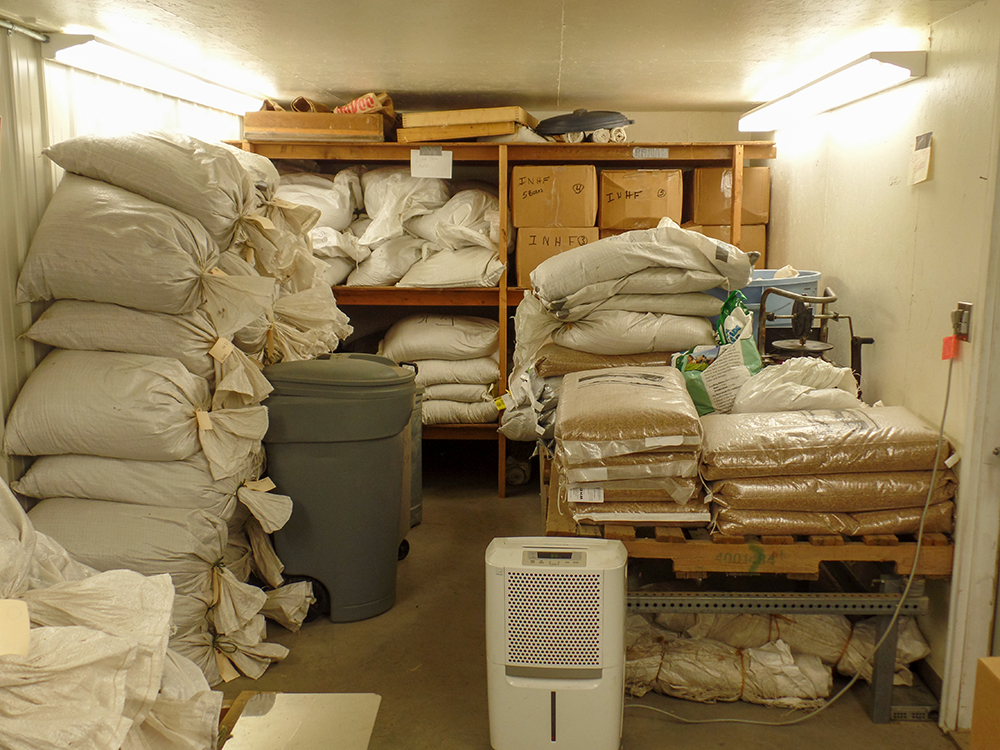
Ideal seed storage specifications vary with individual species, but most can be stored in a temperature- and humidity-controlled environment for at least a year without significant loss of viability. Some IRVM programs have a dedicated seed storage facility. These insulated rooms and small buildings are rodent-proof, air-conditioned, and sometimes have industrial dehumidifiers. In the absence of a dedicated seed storage facility, seed should be stored in the coolest place possible. Air circulation can improve conditions if it is impossible to control temperature and humidity. Most seeds can tolerate short periods of storage in temperatures over 100°F, but long-term exposure to such heat can destroy embryos.
No reliable scientific guidelines support increasing seeding rates to account for lower seed viability when stored in suboptimal temperature and humidity conditions. Instead, the safest bet is to find funding for a proper seed storage facility to ensure seed viability.
Commercially produced seed is properly dried before being bagged. For counties and cities growing their own seed and bagging it, seed storage bags should be made of breathable materials such as cloth or woven nylon. Well-dried seed (8–14% moisture content, depending on the species) can be bagged and stored in garbage cans, larger plastic bags, or other sealed containers without suffering damage from fungus or freezing. Seed should be monitored for moisture buildup. Additional information on seed quality, processing, and storage can be found in the Tallgrass Prairie Center’s Native Seed Production Manual.
Roadside Real Talk
Insights from Roadside Managers and Other Professionals
We’ve noticed Liatris grows very poorly unless it’s dormant seeded shortly after harvest. Perhaps it loses viability or vigor when stored over winter, or maybe it needs to be stored at a higher humidity than most seed.
—Jim Uthe and James Devig, Dallas County, 2024
With a little increase in rate per acre, I think year-old seed can be used with no problem. We use older seed (2–3 years) at whatever rate it takes to use it up over the course of the season. I add a reduced rate of new seed to cover any loss of germination.
—Linn Reece, Hardin County, 2010
Seed Mixes
Seed Mixes thompsbbTake advantage of prairie diversity
Native seed mixes for roadsides must include species adapted to various growing conditions, from wet to mesic to dry. In order for the native plants to outcompete weeds, mixes should also include species that occupy different ecological niches, grass and broadleaf species, warm-season and cool-season species, plants that are tall enough that they produce shade that prevents weeds from growing, and small plants to fill in underneath.
When planting in narrow ditches, such as those found within a right-of-way that is 66 feet wide, it is most efficient to design one seed mix that includes species for a wide range of site conditions—from the gravelly, well-drained soils at the top of the slope, to the heavy, saturated soils at the bottom of the ditch. The same mix can be applied over the entire area and left to sort itself out. Wider rights-of-way may have larger wet or dry areas to justify designing and planting a seed mix specific to those spots.
To achieve a well-rounded seed mix with all the benefits of native vegetation, include species from each functional group described below.
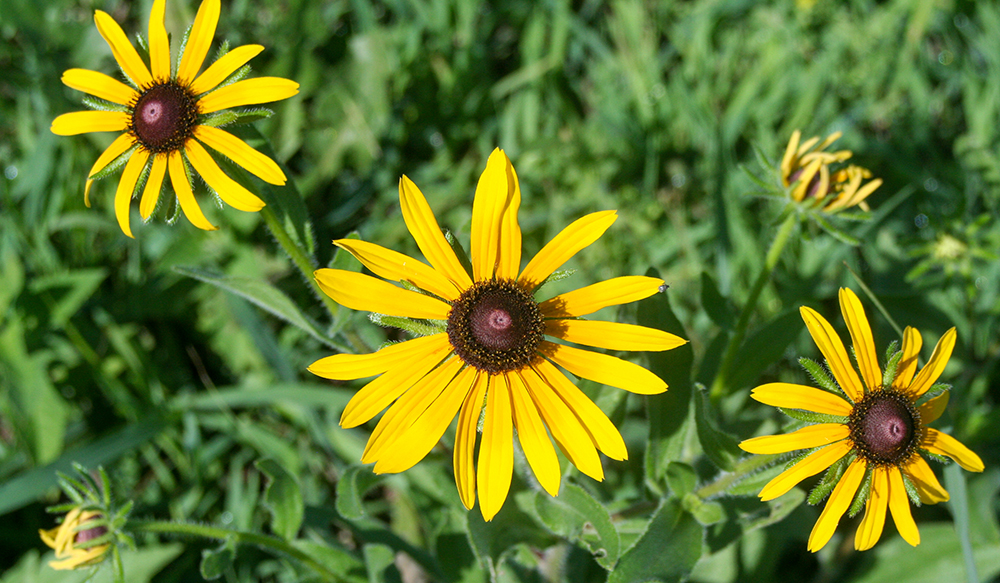
Quick-Establishing
These native species establish faster than others, provide early erosion control, and show demonstrable progress to community members while slower species take longer to establish.
- Canada wildrye (Elymus canadensis)
- Black-eyed Susan (Rudbeckia hirta)
- Rough dropseed (Sporobolus compositus)
- Partridge pea (Chamaecrista fasciculata)
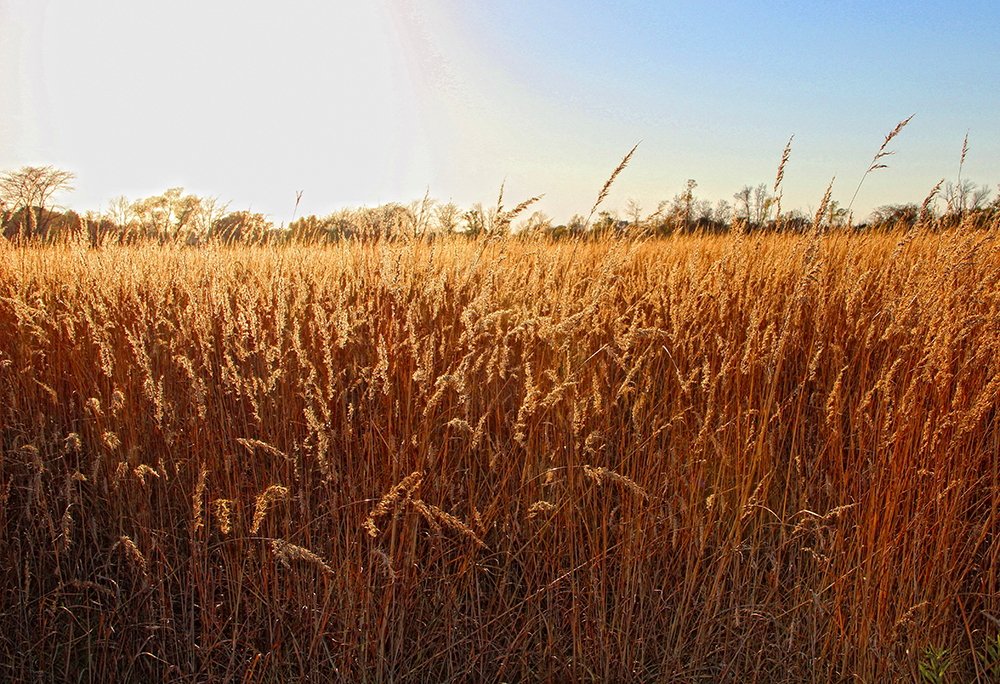
Warm-Season Grasses
Roadside plantings rely heavily on these prominent members of the native plant community. These grasses continue to grow through the hot summer months. They provide long-term erosion control and good fall color.
- Big bluestem (Andropogon gerardii)
- Indiangrass (Sorghastrum nutans)
- Switchgrass (Panicum virgatum)
- Sideoats grama (Bouteloua curtipendula)
Cool-Season Species
Roadside plantings are strengthened by a species component that greens up early in the spring. These plants provide late winter/early spring erosion control and occupy the niche sought by non-native, cool-season competitors like smooth brome.
- Canada wildrye (Elymus canadensis)
- Virginia wildrye (Elymus virginicus)
- Western wheatgrass (Pascopyrum smithii, also known as Agropyron smithii and other alternate names)
- Sedges (Carex spp.; “spp.” means “several species” in scientific terminology. One to four sedge species may be included in the seed mix depending on which sedge species are available.)
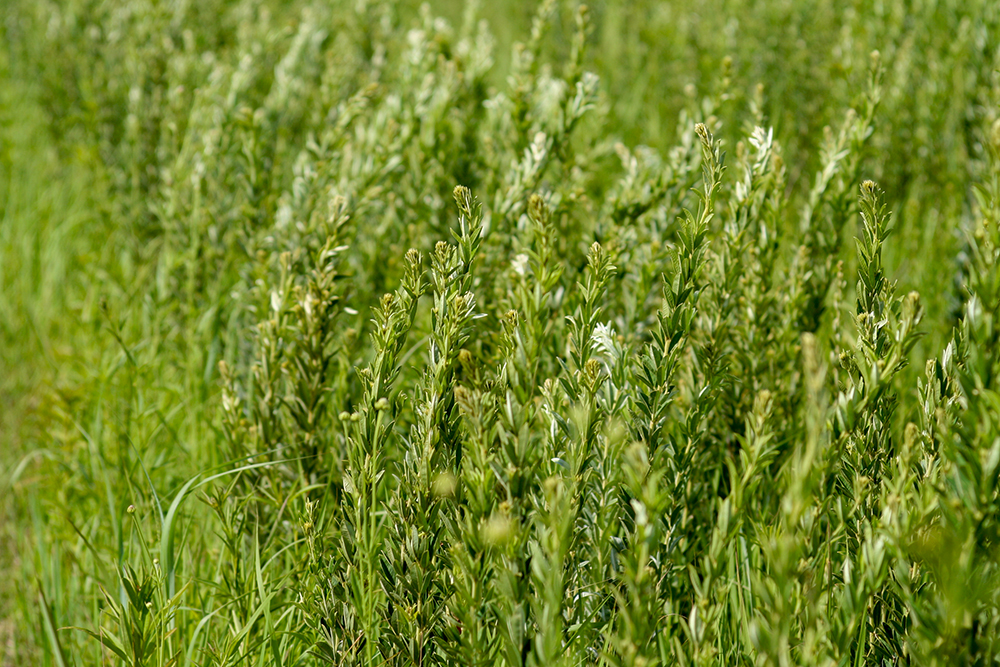
Legumes
The prairie flora includes many legumes that thrive in roadside plantings. They fix nitrogen, or in other words, with the help of bacteria that grow on their roots, they convert atmospheric nitrogen gas that plants cannot use into a usable form of nitrogen, such as nitrate, that plants can use to grow. When legumes die and decompose, the nitrogen in their root and leaf tissue is released into the soil. By making nitrogen more readily available in the soil to various plant species, legumes improve growing conditions for many different types of plants.
- White wild indigo (Baptisia alba)
- Round-headed bush clover (Lespedeza capitata)
- Showy tick-trefoil (Desmodium canadense)
- Canada milkvetch (Astragalus canadensis)
- Purple prairie clover (Dalea purpurea)
Showy and Easy
These crowd pleasers establish readily, are relatively inexpensive, and create masses of color noticeable to residents swiftly driving by.
- Gray-headed coneflower (Ratibida pinnata)
- Oxeye sunflower (Heliopsis helianthoides)
- Wild bergamot (Monarda fistulosa)
- New England aster (Symphyotrichum novae-angliae)
- Black-eyed Susan (Rudbeckia hirta)

Showy
The following species cost a little more or are harder to establish but still add important color and habitat.
- Butterfly milkweed (Asclepias tuberosa)
- Prairie blazing star (Liatris pycnostachya)
- Compass plant (Silphium laciniatum)
- Pale purple coneflower (Echinacea pallida)
- Stiff goldenrod (Oligoneuron rigidum)
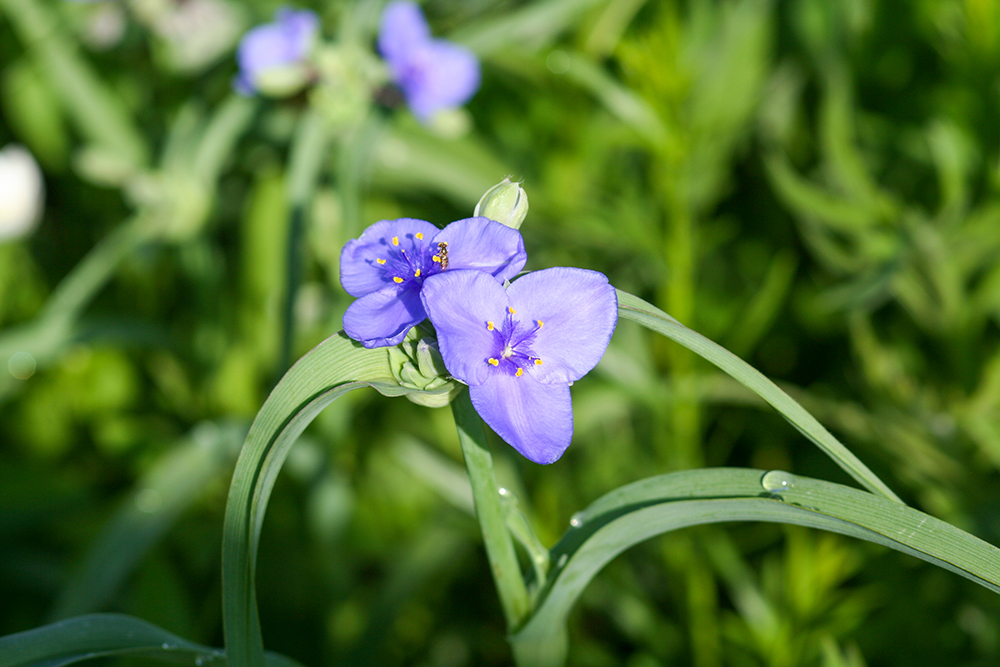
Early Bloomers
Extending a planting’s blooming season into the fall is relatively easy, but spring color is harder to come by. The following plants provide the earliest color visible from the road.
- Ohio spiderwort (Tradescantia ohiensis)
- Foxglove beardtongue (Penstemon digitalis)
- Golden Alexanders (Zizia aurea)
- Large-flowered beardtongue (Penstemon grandiflorus)
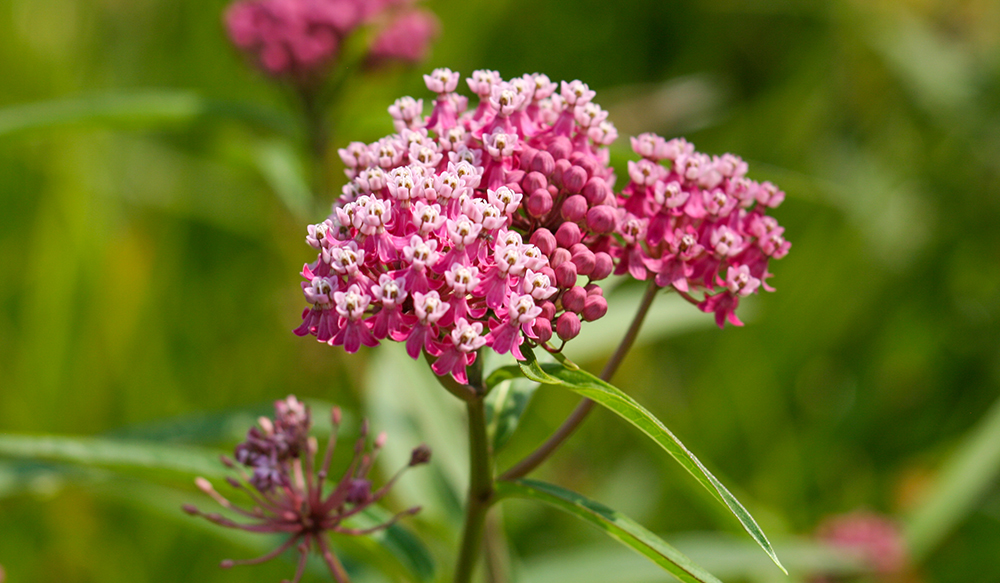
Wet Species
Upland species that are adapted to dry (xeric) or moderate soil moisture (mesic) conditions dominate roadside seeding mixes to reflect the growing conditions along the upper and middle part of the ditch. Species adapted to wet areas are needed for moist ditch bottoms.
- Bluejoint grass (Calamagrostis canadensis)
- Swamp milkweed (Asclepias incarnata)
- Dark green bulrush (Scirpus atrovirens)
- Sneezeweed (Helenium autumnale)
- Mountain mint (Pycnanthemum virginianum)
For additional assistance with designing seed mixes, see the Tallgrass Prairie Center’s Designing Seed Mixes technical guide and seed calculator.
A Note About Tall Grasses and Non-Native Perennials
For visibility and safety, tall grasses—such as big bluestem and Indiangrass—should not be planted at intersections or driveways. However, omitting these grasses from other roadside areas will limit a planting’s adaptability. Big bluestem and Indiangrass are versatile and adapted to conditions from medium-dry to medium-wet. Short native grasses, on the other hand, are generally adapted only to dry sites.
Non-native perennials—such as tall fescue, perennial ryegrass, crown vetch, and birdsfoot trefoil—are very competitive and will persist to the point of adversely affecting the survival of native seedlings. These species should not be used in permanent or temporary mixes for native plantings.
Seed Mixes for Shoulders
Native species are not to be planted on the shoulder. Seed mixes that withstand repeated mowing and are well-suited to shoulder conditions include:
- 50% Kentucky 31 fescue (note: this is a tall fescue that is distinct from Kentucky bluegrass) and 50% perennial rye
- 45% Kentucky 31 fescue, 45% perennial rye, 6% medium red clover, and 4% alsike clover
- 35% fawn tall fescue, 35% perennial rye, 20% Timothy, and 10% alfalfa or hairy vetch
Roadside Real Talk
Insights from Roadside Managers and Other Professionals
Keep in mind, in most situations, we’re not recreating a diverse prairie. We’re stabilizing the roadside with native plants.
We use local ecotype hand-harvested forbs and combined seed from our native seed nurseries to add diversity to our roadside seed mixes.
Try to tailor your mix so the right-of-way has color all year long.
—Joe Kooiker, Story County, 2024
Aspect and shading sometimes need to be taken into account, especially on small plantings or problem areas. In shaded areas, we use savanna species in the mix. If there’s a lot of shade, we may plant a non-native, cool-season mix.
Depending on soil type, we may use up to one-and-a-half times the rate of native seed to help speed establishment and stabilization.
—Jim Uthe and James Devig, Dallas County, 2024
Seeding Rates
Seeding Rates thompsbbPut Down Enough Good Seed to Get Timely Vegetative Cover and Ensure Planting Success
Steeper slopes require heavier seeding rates. To achieve adequate erosion control, increasing the amount of grass in the mix is more cost-efficient than increasing the forbs. As a result, roadside plantings tend to have a higher grass-to-forb ratio than other prairie restorations. No matter how much native grass seed is included, at least 25% of the mix’s weight should be a forb component to achieve adequate diversity and long-term stability. For even more diversity that will provide more visual appeal to drivers and attract pollinators, increase the proportion of forbs to 50%. Some counties and cities—especially those with their own forb seed plots—may exceed 50% forb content for intersections and other highly visible plantings.
Seeding rates are calculated in one of two ways:
- seeds per square foot (seeds/sq. ft.)
- pounds per acre (lbs./acre)
Though frequently used, lbs./acre is not a precise way of measuring the number of seeds planted since seed weights vary greatly between species. For example, one ounce of compass plant contains 660 seeds, while one ounce of black-eyed Susan contains 92,000 seeds. Under actual working conditions, even the best attempts at measuring seed quantities in the field will be imprecise. However, for the most accurate calculation of seeding rates, use seeds/sq. ft.
Seeding rates for roadside mixes are determined by the slope of the roadside where the seeds will be planted, the species being planted, and, to a lesser degree, the seeding method that will be used (i.e., drill seeding, broadcast seeding, or hydroseeding). Cost can also be a factor. The following chart provides general guidelines for how many seeds should be planted.
| Wildflowers | Native Grasses | ||
|---|---|---|---|
| Level sites: | 2 lbs./acre or 10 seeds/ft. | + | 7.5 lbs/acre or 30 seeds/ft. |
| 3:1 slopes: | 3 lbs./acre or 15 seeds/ft. | + | 11 lbs./acre or 45 seeds/ft. |
| 2:1 slopes: | 4 lbs./acre or 20 seeds/ft. | + | 15 lbs./acre or 60 seeds/ft. |
These rates apply to drill seeding, broadcast seeding, and two-pass hydroseeding. When hydroseeding with seed mixed in the slurry (one-pass method), increase rates by 15–30% to compensate for seeds that are stuck in the mulch, preventing the seed-to-soil contact needed for the soil to germinate.
Appendix 4B contains a sample diversity mix and ditch cleanout mix with seeding rates for a 2:1 slope. The seeding rates can be adjusted, depending on the slope of the roadside and the seeding method being used.
For additional assistance creating custom seed mixes, visit the Tallgrass Prairie Center’s Iowa Prairie Seed Calculator. This web resource allows users to enter variables such as soil moisture, seeding method, planting season, etc., and get a custom-recommended native prairie seed mix with a cost estimate and a list of vendors who sell the seeds in the mix.
